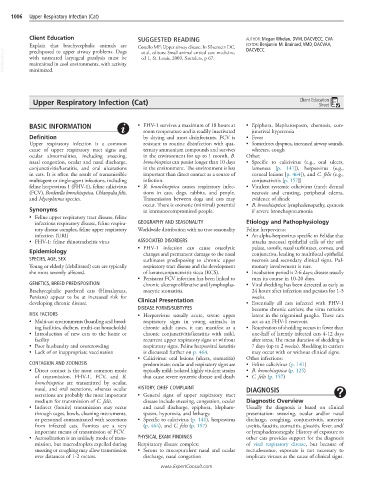Page 2009 - Cote clinical veterinary advisor dogs and cats 4th
P. 2009
1006 Upper Respiratory Infection (Cat)
Client Education SUGGESTED READING AUTHOR: Megan Whelan, DVM, DACVECC, CVA
Explain that brachycephalic animals are Costello MF: Upper airway disease. In Silverstein DC, EDITOR: Benjamin M. Brainard, VMD, DACVAA,
DACVECC
VetBooks.ir with untreated laryngeal paralysis must be ed 1, St. Louis, 2009, Saunders, p 67.
predisposed to upper airway problems. Dogs
et al, editors: Small animal critical care medicine,
maintained in cool environments, with activity
minimized.
Upper Respiratory Infection (Cat) Client Education
Sheet
BASIC INFORMATION • FHV-1 survives a maximum of 18 hours at • Epiphora, blepharospasm, chemosis, con-
room temperature and is readily inactivated junctival hyperemia
Definition by drying and most disinfectants. FCV is • Fever
Upper respiratory infection is a common resistant to routine disinfection with qua- • Sometimes dyspnea, increased airway sounds,
cause of upper respiratory tract signs and ternary ammonium compounds and survives wheezes, cough
ocular abnormalities, including sneezing, in the environment for up to 1 month. B. Other:
nasal congestion, ocular and nasal discharge, bronchiseptica can persist longer than 10 days • Specific to calicivirus (e.g., oral ulcers,
conjunctivitis/keratitis, and oral ulcerations in the environment. The environment is less lameness [p. 141]), herpesvirus (e.g.,
in cats. It is often the result of transmissible important than direct contact as a source of corneal lesions [p. 464]), and C. felis (e.g.,
multiagent or single-agent infections, including infection. conjunctivitis [p. 157])
feline herpesvirus 1 (FHV-1), feline calicivirus • B. bronchiseptica causes respiratory infec- • Virulent systemic calicivirus (rare): dermal
(FCV), Bordetella bronchiseptica, Chlamydia felis, tions in cats, dogs, rabbits, and people. necrosis and crusting, peripheral edema,
and Mycoplasma species. Transmission between dogs and cats may evidence of shock
occur. There is zoonotic (minimal) potential • B. bronchiseptica: lymphadenopathy, cyanosis
Synonyms in immunocompromised people. if severe bronchopneumonia
• Feline upper respiratory tract disease, feline
infectious respiratory disease, feline respira- GEOGRAPHY AND SEASONALITY Etiology and Pathophysiology
tory disease complex, feline upper respiratory Worldwide distribution with no true seasonality Feline herpesvirus:
infection (URI) • An alpha-herpesvirus specific to Felidae that
• FHV-1: feline rhinotracheitis virus ASSOCIATED DISORDERS attacks mucosal epithelial cells of the soft
• FHV-1 infection can cause osteolytic palate, tonsils, nasal turbinates, cornea, and
Epidemiology changes and permanent damage to the nasal conjunctiva, leading to multifocal epithelial
SPECIES, AGE, SEX turbinates predisposing to chronic upper necrosis and secondary clinical signs. Pul-
Young or elderly (debilitated) cats are typically respiratory tract disease and the development monary involvement is rare.
the most severely affected. of keratoconjunctivitis sicca (KCS). • Incubation period is 2-6 days; disease usually
• Persistent FCV infection has been linked to runs its course in 10-20 days.
GENETICS, BREED PREDISPOSITION chronic ulceroproliferative and lymphoplas- • Viral shedding has been detected as early as
Brachycephalic purebred cats (Himalayans, macytic stomatitis. 24 hours after infection and persists for 1-3
Persians) appear to be at increased risk for Clinical Presentation weeks.
developing chronic disease. • Essentially all cats infected with FHV-1
DISEASE FORMS/SUBTYPES become chronic carriers; the virus remains
RISK FACTORS • Herpesvirus: usually acute, severe upper latent in the trigeminal ganglia. These cats
• Multi-cat environments (boarding and breed- respiratory signs in young animals; in act as an FHV-1 reservoir.
ing facilities, shelters, multi-cat households) chronic adult cases, it can manifest as a • Reactivation of shedding occurs in fewer than
• Introduction of new cats to the home or chronic conjunctivitis/keratitis with mild, one-half of latently infected cats 4-12 days
facility recurrent upper respiratory signs or without after stress. The mean duration of shedding is
• Poor husbandry and overcrowding respiratory signs. Feline herpesviral keratitis 7 days (up to 2 weeks). Shedding in carriers
• Lack of or inappropriate vaccination is discussed further on p. 464. may occur with or without clinical signs.
• Calicivirus: oral lesions (ulcers, stomatitis) Other infections:
CONTAGION AND ZOONOSIS predominate; ocular and respiratory signs are • Feline calicivirus (p. 141)
• Direct contact is the most common mode typically mild; isolated highly virulent strains • B. bronchiseptica (p. 125)
of transmission. FHV-1, FCV, and B. that cause severe systemic disease and death • C. felis (p. 157)
bronchiseptica are transmitted by ocular,
nasal, and oral secretions, whereas ocular HISTORY, CHIEF COMPLAINT DIAGNOSIS
secretions are probably the most important • General signs of upper respiratory tract
medium for transmission of C. felis. disease include sneezing, congestion, ocular Diagnostic Overview
• Indirect (fomite) transmission may occur and nasal discharge, epiphora, blepharo- Usually the diagnosis is based on clinical
through cages, bowls, cleaning instruments, spasm, hyporexia, and lethargy. presentation: sneezing, ocular and/or nasal
or personnel contaminated with secretions • Specific to calicivirus (p. 141), herpesvirus discharge, coughing, conjunctivitis, anterior
from infected cats. Fomites are a very (p. 464), and C. felis (p. 157) uveitis, faucitis, stomatitis, glossitis, fever, and/
important means of transmission of FCV. or lymphadenomegaly. History of exposure to
• Aerosolization is an unlikely mode of trans- PHYSICAL EXAM FINDINGS other cats provides support for the diagnosis
mission, but macrodroplets expelled during Respiratory disease complex: of viral respiratory disease, but because of
sneezing or coughing may allow transmission • Serous to mucopurulent nasal and ocular recrudescence, exposure is not necessary to
over distances of 1-2 meters. discharge, nasal congestion implicate viruses as the cause of clinical signs.
www.ExpertConsult.com

